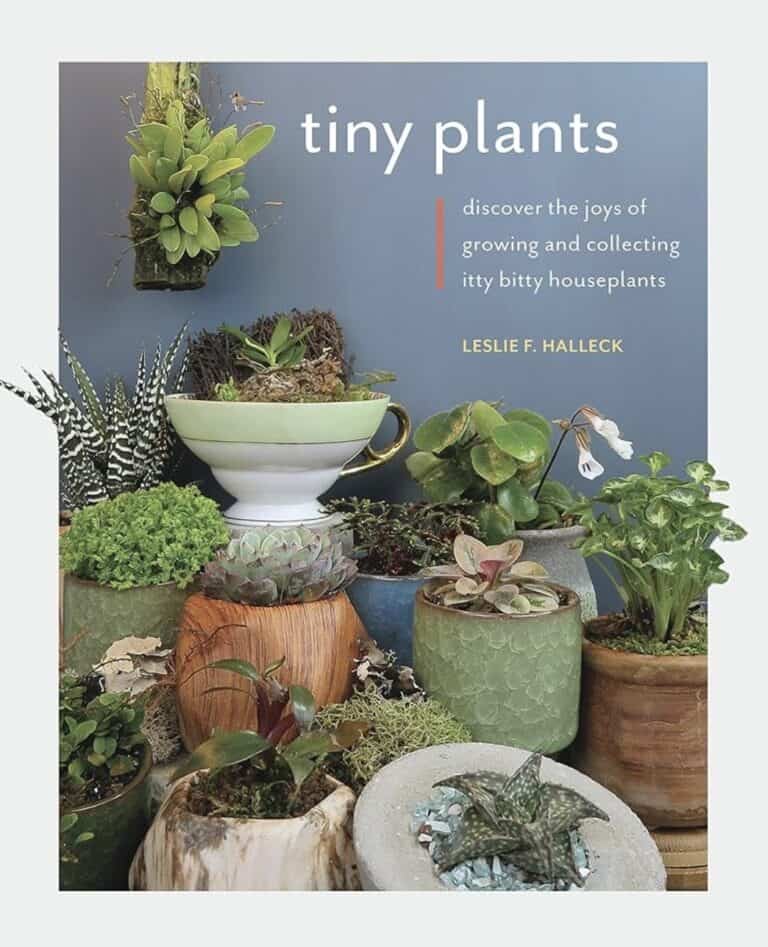
Tiny Plants: Discover the joys of growing and collecting itty-bitty houseplants
By Leslie F. Halleck
2021
Review by Karen Smith
Like most lovers of all things “garden,” there comes a time when we absolutely have no room for one more plant. I think this is why this book appealed to me as it allowed me to continue my passion on a much smaller scale. Surely most people must have a windowsill or desktop that needs a bit of “greenery!”
The author’s fascination with tiny plants began on a trip to Puerto Rico where she happened upon a collection of tiny orchids. It was then that she became “hooked on all things tiny.”
The book begins with a discussion of tiny plant botany and why being so small can be an advantage. Lots of tiny plants can fit into tiny spaces!
As these plants grow in different climates, geographical regions, and micro-habitats, it is necessary to first provide a basic explanation of the various natural environments where these plants grow. When establishing a home for your tiny plants, try to recreate an artificial environment that resembles a plant’s natural growing conditions for best results.
- Terrestrial – land growing plants
- Epiphyte – germinates and grows on other plants (ex: orchids)
- Hemiepiphyte – germinates on other plants or ground, roots in soil or aerial (ex: monstera)
- Lithophyte – grows in or around rocks (ex: algae)
- Chasmophyte – grows in crevices where organic matter has collected (ex: carnivorous plants)
- Aquatic – grows submerged in water or with foliage just above (ex: anubias)
The selection of a container is an important consideration. Unglazed clay or unsealed concrete are often the preferred choice as it allows air to move through the material, but in some cases sealed pots are best for plants that are tropical. Drainage is necessary, even for plants that need moisture, to prevent decay. Growing media varies depending on the plant and its native habitat. Plants that struggle are often the result of using an incorrect type of media. And last, but not least, watering, humidity, feeding and light exposure all need to be taken into consideration in order to be successful in growing tiny plants.
In addition to traditional containers, tiny plants can also be grown in different types of terrariums (open, closed) since this provides a suitable environment for moisture loving plants. This type of container can be as simple as a glass jar, or as elaborate as an orchidarium or aquarium. The author provides instructions for layering substrates, which creates artificial drainage to prevent rotting.
After the basics are covered, a variety of foliage, flowering, succulents and cacti, carnivorous, semi-aquatic plants are listed with detailed growing requirements. Included in each chart are: plant type, skill level, light, soil, moisture, humidity, temperature, fertilizer size, propagation, and suggestions of other plants that are grown in the same way. Excellent photos of each plant, taken by the author, accompany all of the selections. It was so helpful to actually see these plants and how they were displayed in their respective containers.
The next group of tiny plants presented are ones that grow well in glass enclosures. These include foliage, flowering, aquatic and semi-aquatic plants. A chart and photo is included for each selection in this section as well.
To conclude the book, the author presents creative and unusual ways to group and display your new acquisitions, with wonderful photographs to inspire your creativity.
And if you don’t know where to start, there is a chart of resources where you can obtain plants, supplies, accessories, grow lights, and tools.
